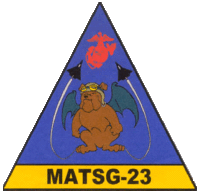- Marine Aviation Training Support Group 23
-
Marine Aviation and Training Support Group 23 
MATSG-23 insigniaActive March 1, 1942 – November 1, 1945
January 15, 1982 - presentCountry United States Branch United States Marine Corps Role Training Garrison/HQ Naval Air Station Lemoore Engagements World War II
* Battle of GuadalcanalCommanders Current
commanderLtCol Michael D. Bryan Marine Aviation and Training Support Group 23 (MATSG-23) is a United States Marine Corps aviation training group that was originally established during World War II as Marine Aircraft Group 23 (MAG-23). Squadrons from MAG-23, augmented by Navy and Army flying units formed the Cactus Air Force during the Battle of Guadalcanal. The group was deactivated at the end of the war and was not reactivated until January 15, 1982 when Marine Aviation and Training Support Group NAS Lemoore was renamed MATSG-23.
Contents
Mission
Provide administration and training support to all Marines aboard NAS Lemoore. They also provide ceremonial support for base and local events in the form of color guards and special detail advisors.
History
World War II
Marine Air Group 23 was commissioned at Marine Corps Air Station Ewa, Hawaii, as part of the 2nd Marine Aircraft Wing on March 1, 1942. The group became the first Marine aviation group to meet the Japanese in the South Pacific. They formed the forward echelon of the 1st Marine Aircraft Wing (1st MAW) during the Battle of Guadalcanal and landed its first units at Henderson Field, Guadalcanal on August 20, 1942 when VMF-223 and VMSB-231 were flown off the USS Long Island (CVE-1). Ten days later the group's rear echelon, composed of VMF-224 and VMSB-232, joined the forward echelon at Henderson Field. MAG-23, augmented by Army and Navy land based air under the operational control of 1st MAW, furnished air support to the 1st Marine Division and Army ground forces in the struggle for Guadalcanal. Although the Group itself comprised only four Marine squadrons, personnel and aircraft of six Navy carrier squadrons, (VS-5, VB-6, VF-5, VS-71, VT-8 and VS-3) the 67th Army Pursuit Squadron, and detachments of Marine squadrons stationed at various South Pacific bases operated with MAG-23. This heterogeneous group shot down 244 enemy planes in four weeks. Navy pilots accounted 44, Army flyers, using P-400s shot down eight. The remaining 192 were credited to Marines. The price of that score was 22 Marine pilots killed in action, three by enemy naval gunfire. From Guadalcanal MAG-23 was transferred to the Naval Air Station San Diego where it served from November 18, 1942 until January 9, 1943. The group was then transferred to Marine Corps Air Station El Toro until September 1943. On September 19, 1943, the group again landed at MCAS Ewa and remained there as part of Marine Air Hawaiian Area until May 1944. On May 8, 1944, the group transferred to Midway Atoll where it remained until the war ended. MAG-23 later returned to the West Coast and was decommissioned on November 1, 1945.
1980s to present
Marine Aviation Training Support Group NAS Lemoore was formally activated on January 15, 1982 with mission of providing administrative and limited logistics support to Marines permanently and temporarily assigned to Naval Air Station Lemoore in support of F/A-18 Hornet maintenance, operations and training. On July 2, 1982, VMFA-314 arrived at NAS Lemoore as the first squadron to transition to the F/A-18 Hornet. By the end of June 1983, the first three Marine F/A-18 squadrons had completed their transition at VFA-125. Over the years, F/A-18 training switched from whole units to individual Marines destined to replace Marines in the Fleet Marine Force.
In May 2000, the Commandant of the Marine Corps directed the re-designation of MATSG NAS Lemoore as Marine Aviation Trainings Support Group 23. All Marine Aviation Training Support Groups were redesignated to promote a sense of Marine Corps identity and tradition and allows them and their history to live on.
See also
References
 This article incorporates public domain material from websites or documents of the United States Marine Corps.
This article incorporates public domain material from websites or documents of the United States Marine Corps.
External links
Categories:- United States Marine Corps aircraft groups
- Military units and formations in California
Wikimedia Foundation. 2010.

